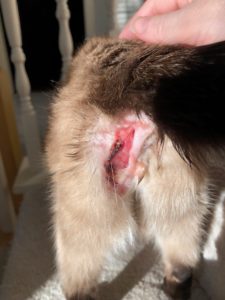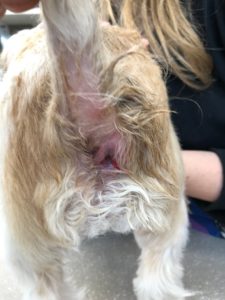The anal glands are two small sacs located on either side of a dog or cat’s anus. They produce an oily, foul-smelling liquid that pets use to mark their territory. Usually, the anal glands are drained when your pet has a bowel movement. Anal gland problems occur when the glands become impacted and are unable to drain. This can lead to inflammation, infection, and abscesses.
Causes of Anal Gland Problems
Anal gland problems are more common in dogs than cats. They are usually seen most frequently in small breed dogs such as Chihuahuas and Dachshunds. Senior and overweight pets are also prone to developing the problem as their anal glands often do not function efficiently.
Other underlying causes of anal gland problems include damage to the ducts that drain the glands. This can be caused by factors such as infection, trauma, allergies, or inflammation. Poor nutrition can also lead to soft stools which do not exert enough pressure to empty the anal glands properly.
Symptoms of Anal Gland Problems
Pets with anal gland problems will often scoot along the floor in an effort to relieve their discomfort. They may also habitually lick or bite the affected area. Another common symptom is constipation or pain when passing feces.
One of the most unpleasant symptoms for pet owners is a foul smell that can be transferred to carpets, clothes, or furniture your pet comes into contact with. Take your pet to the veterinarian if they display any of these symptoms to prevent potential health complications.
Diagnosis of Anal Gland Problems
When diagnosing anal gland problems, your veterinarian will look at your pet’s medical history and perform a physical examination. A rectal examination will also be necessary to check for impaction or inflammation of the anal glands. Your veterinarian may then recommend additional tests such as blood work, urinalysis, a fecal examination, or X-rays to rule out other health issues that may be contributing to the problem.
Treatment of Anal Gland Problems
Your veterinarian will gently push on the outside of the anal glands to express them. If the glands are infected, they may be flushed out to remove any remaining material. Your veterinarian may also prescribe antibiotics to treat infection, or other treatment methods such as warm compresses.
An abscessed anal gland will usually require surgery to drain fluid and repair damaged tissue. If anal gland problems persist, your veterinarian may suggest removal of the glands. The outlook for pets that undergo anal gland surgery is usually very good. Please follow your veterinarian’s treatment instructions carefully to help your pet heal.
Prevention of Anal Gland Problems
Feed your pet a healthy diet and make sure they get plenty of exercise to prevent them becoming overweight. Ask your veterinarian if you need advice on exercising your pet or selecting a healthy and nutritious food that will support their overall health. It’s also important to schedule regular anal gland expressions if your pet is prone to anal gland problems.



